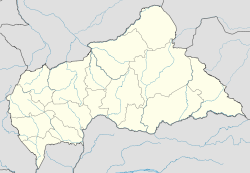Boali | |
|---|---|
 The Falls of Boali | |
| Coordinates: 4°48′N18°7′E / 4.800°N 18.117°E | |
| Country | Central African Republic |
| Prefecture | Ombella-M'Poko |
| Government | |
| • Sub-Prefect | Solange Mokolomboka Soza Makanda [1] |
| • Mayor | Pierre Poutou [2] |
| Population (2012) [3] | |
• Total | 9,314 |
Boali is a town located in the Central African Republic prefecture of Ombella-M'Poko.
Contents
Boali is located on National Highway 1 (RN1), [4] about 100 km northwest of the national capital, Bangui. [5] The road, one of the country's few paved highways, leads on to Bouar, and ultimately to Cameroon. [6]
Situated on the Mbali River, Boali is noted for its waterfalls and for the nearby hydroelectric works. The Falls of Boali are 250 m wide and 50 m high, and are a popular tourist destination. [6]
The two units of the Boali Hydroelectric Power Station, Boali I and Boali II, are located below the falls. They have a combined generating power of 18.65 megawatts, and are operated by the state-run Enerca. [7] The completion of Boali I in the 1950s spurred several other industrial developments in the town, including the country's first textile mill, which began operating in 1954. [8]
The Boali hydroelectric works supply power to the capital and 13 other towns. [7]

